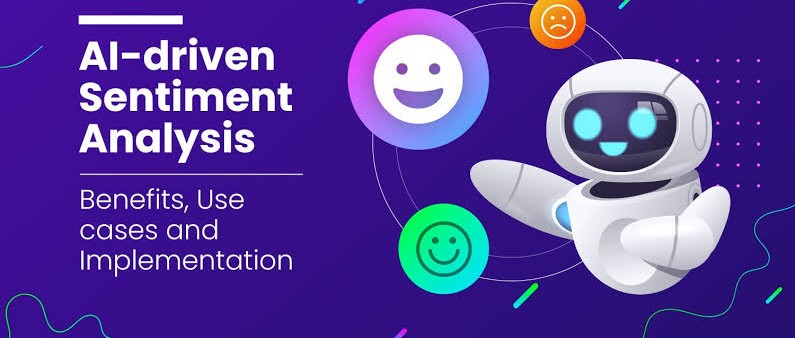Explore how AI-driven sentiment analysis can help businesses understand customer feedback by classifying sentiments in reviews, social media, and customer service interactions. Learn about key techniques, applications, challenges, and best practices for leveraging sentiment analysis to improve decision-making and customer relationships.
AI-Driven Sentiment Evaluation. Understanding Customer Perspectives Sentiment evaluation, commonly known as opinion exploration is a field of intelligence (AI) focused on recognizing and interpreting emotions expressed in writing. This technology is gaining popularity among companies aiming to understand feedback and improve their products. By leveraging sentiment analysis powered by AI businesses can gain insights into customer opinions, preferences and emotions leading to better decision making and fostering stronger customer relationships.
Understanding Sentiment Analysis
Sentiment analysis uses algorithms and machine learning techniques to analyze data and determine its sentiment. The goal is to classify text as positive, negative or neutral. Advanced sentiment analysis systems can also identify emotions such, as joy, frustration, sadness and surprise.
AI powered sentiment analysis often relies on processing (NLP). This field of AI focuses on how computers understand and interact with language. NLP techniques enable machines to grasp, interpret and generate language in a way.
There are several uses for AI driven sentiment analysis, in business operations. Customer feedback plays a role here and AI sentiment analysis presents opportunities for companies. One significant application involves monitoring and evaluating customer reviews and ratings. By automatically categorizing feedback into groups, like positive, negative or neutral businesses can quickly identify areas for improvement and address customer concerns.
Another relevant application involves monitoring media. With the growth of platforms customers frequently share their opinions and experiences online. AI driven tools can sift through media for mentions and assess the sentiment behind these posts. This enables businesses to gauge how they are viewed track their brand reputation and address customer inquiries or grievances more effectively.
Moreover AI based sentiment analysis can be employed in interactions. By analyzing service emails, chat logs and transcripts of phone conversations companies can gain insights into levels of satisfaction and identify recurring problems. This data can be utilized to train service representatives refine support strategies and improve the overall customer journey.
Techniques and Technologies
Sentiment analysis powered by AI relies on a range of techniques and technologies to achieve its outcomes. One approach involves classifying text where machine learning models are trained to categorize text into sentiment groups. A commonly used method is learning which entails training models with datasets that have sentiment labels assigned to each piece of text. These models learn from the data to make predictions, on text.
Another approach is based on sentiment lexicons, which are dictionaries that associate words and phrases with specific sentiments. By analyzing how often these words appear in text sentiment analysis tools can infer the overall sentiment. This method is often combined with learning techniques to improve accuracy and adapt to language patterns.
Recent advancements in learning particularly with neural networks have improved sentiment analysis. Recurrent Neural Networks (RNNs) and transformers are two frameworks that effectively understand context and handle dependencies in text. These architectures can capture sentiment nuances leading to improved accuracy in sentiment analysis tools.
Challenges and Limitations
While AI powered sentiment analysis offers benefits it also faces obstacles and challenges. A significant challenge arises from the complexities of language. Text can be subject to interpretations influenced by context and shaped by elements such as sarcasm, irony and informal expressions. AI algorithms may struggle to capture these nuances resulting in misinterpretations of sentiment.
Another limitation is the reliance on data. Sentiment analysis tools are trained on sets and their performance can be affected by the quality and diversity of the data. Models trained on datasets or incomplete data may produce biased results and struggle to adapt to new contexts.
Furthermore sentiment analysis systems may encounter difficulties when dealing with variations in text or language. Addressing dialects requires specialized models and approaches to ensure sentiment detection, across scenarios.
Best Practices for Implementing Sentiment Analysis.
To successfully implement sentiment analysis powered by AI businesses should adhere to a set of practices. Firstly selecting the appropriate sentiment analysis tool or platform is essential. Considerations such, as accuracy, scalability, language support and integration capabilities with existing systems are crucial.
Secondly it's vital to use high quality and representative data for training sentiment analysis models. Regularly updating and refining these models based on feedback can improve accuracy and keep up with evolving language patterns.
Thirdly combining analysis with human oversight can enhance the reliability of the results. While AI can handle amounts of text human reviewers can provide context and insights that automated systems may overlook.
Lastly leveraging insights gained from sentiment analysis to drive improvements is essential. These insights should guide business strategies enhance customer service and address areas of concern. By consistently monitoring and assessing sentiment trends businesses can remain responsive to customer preferences and needs.
In conclusion the use of powered sentiment analysis proves to be a valuable asset in understanding customer perceptions and improving operational efficiency. By leveraging methods and technologies businesses can gain insights, into customer sentiments and thoughts thereby refining their products and fostering stronger relationships. Despite facing obstacles and limitations following best practices can aid companies in effectively incorporating sentiment analysis and achieving meaningful advancements.
